No, you haven’t misread the nameplate. It isn’t missing any characters or been badly labeled when a label may have been re-applied. This is a Remington J – which is known in the USA as the Remington Junior. Why? Well, we’ll get to that in a moment.
My collecting has taken a bit of an interesting turn lately. I never intended for it to go in this direction, but it has and I have to say it’s a good thing. I decided sometime back to focus on Art Deco and Art Nouveau typewriters for my collection, however I strayed quite wide of that and found myself picking up machines of beauty and writing grace. Olympia SM machines, Hermes 3000s. Wonderful Adler and Triumph machines of the 50’s 60’s and 70’s. All these machines are incredible writing workhorses that simply look… incredible.
But lately older machines from another age have been creeping into my collection. Machines that I previously never really had much of an interest in. The kind of machines that you read about in ETCetera. Territory that I have only really dipped my toes into.
And so enter the Remington J. A machine I have really enjoyed working on, and it has had me thinking a lot about other typewriters of the era.
This machine is a challenger to my Demountable for being the best typewriter rest your coffee cup on. Just look at that big flat cover-plate on the top. However the action on this machine is very smooth and responsive, and doesn’t lend to finger fatigue as quickly as the Demountable. Online I’ve read a lot of comparisons with this machine to the Harris Visible – the Demountable’s precursor machine. But to be honest I feel that’s doing an injustice to this machine.
I spotted this Remington J on Gumtree a couple of weeks ago. The seller really just wanted to sell it locally and get it out of her house quickly, so she put a price on it of $26. I knew it would be only a question of time where at that price it would fall afoul of a key chopper, and as I am building up a little collection of Remingtons in honour of my late Remington employed Grandfather – I jumped on this machine and negotiated with the lady to sell it to me if I organised a courier to collect it. It took me two weeks, and the owner was very lovely throughout the transaction.
And really, I’m likely to have few chances to get my hands on such a machine. This model isn’t exactly something you’ll find every day. The Remington J is known in the USA as the Remington Junior. However it was exported as the ‘J’, as the use of the term junior (as opposed to senior) was only commonplace in the United States. Outside of the USA the term’Junior’ implied that it was very young, underdeveloped or of a lesser standing, and didn’t have the affectionate connotation that it had in this typewriter’s home country. Sticking a typist in front of a machine named a Junior at the time may have implied that a company saw the person of lesser of their colleagues. So as such the use of the word wasn’t seen as commercially a good idea. This would later change as American cinema became commonplace in Australia and other countries in the world, and customers became much more exposed to softer usage of the term.
Mechanically this machine is a magnificent wonder. To the eye it is very rudimentary, but don’t let the simple design of this typewriter fool you. It’s quite a writing tool. The keys respond sharply to the touch and smoothly, and with the wide footprint of this machine, it has great stability. The caps lock is a very rudimentary metal tab that sticks out of the keyboard, and there’s no tabulator. There’s also no colour selector, so you’re restricted to only one tone while writing.
But one of the best things this machine has going for it, is its basket shift design. It’s one of the earliest machines to have introduced the basket shift, and it pre-dated Remington’s use of the system in their standards by a good 20 years. Watching it work is also very enjoyable. While other machines shift up, then shift up again on three-bank keyboards, the Remington J shifts the segment down for capitals, and up for Figures. But not only that, the type bars tile down and up as you do. This makes the type bars look like they are being swung in an arc that follows the circumference of the platen. And really, they are. This system ensures that the typeface is perfectly positioned so that when you swing the type bar on every keypress, it will print the character firmly and flatly.
I also really love the look of the type bars on this machine. They look purposeful.
The Remington Junior was made between 1914 to 1919. As it is a but of a market oddity, it didn’t do all that well and is considered a bit of a commercial fizzer. Its not very portable, and really it wasn’t designed to be. At a time when the Corona 3 was doing so well, there was clearly a market for capable typewriter that was affordable for the home or small office. It was this market that I suspect that the Remington J/Junior was targeted at. Its lack of market success however has meant these machines are quite scarce. Richard Polt’s site even takes a guess that there were about 10,000 made, most of which due to the three-bank keyboard are likely to have been disposed of years ago. The machine was actually made at the Smith Premier typewriter factory, and as such there’s a lot of features on this machine that a similar to those that can be found on the SP machines. This includes the type bars that I find so damn sexy, and a rear-mounted ribbon spool system.
Eventually Remington would pass the construction of this machine over to another company they had worked with known as the American Writing Machine Company. Here, it was refined with a front-mounted ribbon soon system, and had a few more curves added to the design so it didn’t look so utilitarian. But Remington brought out their own new Portable machine, and soon this typewriter’s design was an anachronistic in the modern market, and it faded into obscurity.
When this Remington J machine arrived at my home it came with a sheet of paper wrapped around the platen. As you can see by the photos above, I have not removed this sheet as yet. This is because there’s a good chunk of the typewriter’s history that has been banged into it. Names, phrases and gibberish are written all over it, and it’s a great reminder of the many hands that have no-doubt been at this keyboard before.
As I’m struggling to find a way to get this off without destroying the paper, I’m just going to leave it for now. I don’t think it is going to diminish the usability of the machine at the moment anyway. So… for now, if not forever, It stays.
I’ve given this machine a bit of a cleaning and a service. A such it now works brilliantly. It doesn’t look new but it sure types like it is now. That said, I feel that I’ve progressed a lot with my skills on this machine and whereas a couple of years ago I’d have been very happy to have it just in the condition it is now, these days I feel that I can do so much more with this machine to restore it. I’m confident with a bit of work I can get this machine not only typing like its new, but almost looking like its new. Although I’m determined to preserve all the original decals and paint. The decals on this machine are actually in great condition, and I feel it would do this machine a disservice to strip the original paint, and replace the decals with second-rate water-slide on ones.
So it’s off to the workshop for this machine, so I can bring back as much of the life of the mechanical metal parts as possible, and try out a few new techniques as I do.
The Remington J is a surprisingly accessible machine. Pop off a few screws and much of the machine is completely accessible. It’s also just as easy to put back together. Compared to the Remington 12 – the ‘Senior’ to this machine, this machine is a delight to work on. So I think over time I’ll just do bits and pieces on this machine until I’m happy with the outcome.
But I can’t say I’m disappointed with this typewriter. It’s a great little collector’s piece. and an interesting chapter in Remington’s history. Even if I can’t see myself taking off across the world with this typewriter, I think I’m always going to have a little bit of love for it.
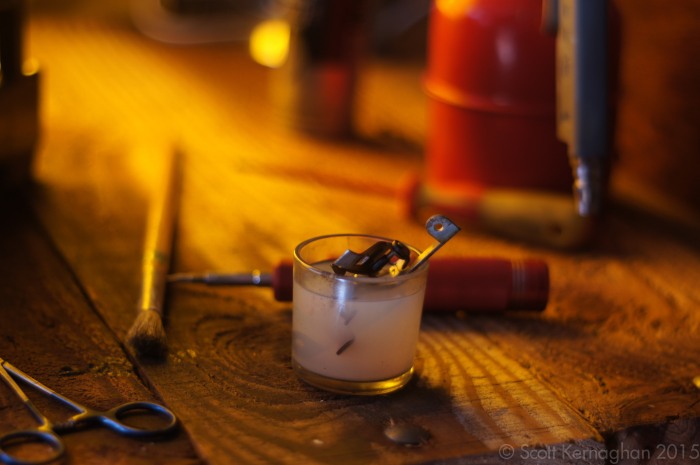
Here, I’m trying to soak part of the ribbon direction switch, which had filled with detritus and wasn’t working very smoothly.
Who knows, I might have it show-room ready by the time I get to organise the next type in. Which, I think I should get onto really soon. I think Melbourne is crying out for a great type-out.
Yep. This Remington J is quite a big step away from the machines that I’ve thus far collected, and have largely avoided.
That isn’t to say that I have never had an interest in the kind of machines that the Early Typewriter Collectors’ Association members love. Richard Polt, Alan Seaver and Herman Price amongst a few others have all shown some incredible machines online that I have found enjoyed looking at, and wished to get my hands on. You can find a lot of these machines on other sites too, and they are frequently written about. I don’t blame them, there’s a lot of interesting machines out their in the older eras. But many of interesting machines featured around other places on the internet that have wonderful artistry in their design, and an air of beauty are sadly when written about they are often reduced to a chunk of paragraphs that describe them as a by-product of what I have described in the past as ‘some white-guy inventing s**t’. I want to know about the influences of the design and the dynamics of the business that drove innovation. I want to read about the souls that have been poured into the keyboard and the drama of the times these machines were used in.
I don’t begrudge such material with a heavy engineering history focus, and I can understand the appeal that it has to many. But I don’t warm to the topic either. It feels like trainspotting to me, and personally I’m much more interested in riding the train and hearing about where it has been than just hearing about the person that drove the making of the train.
However I find my attitudes have been changing of late. I haven’t really sought out these older machines in the past, but I’ve almost accidentally found myself acquiring some really interesting pieces. I’ve had a handful of pre-WW2 typewriters for a while now, but I think my interest in these machines started to change a little more after I got my hands on my apothecary Corona 3, and later the Corona 3 tripod. It wasn’t until I got hold of the Demountable machine that I found my relationship with these typewriters to be quite different when I experience using them in person. There’s much to love in these ageing machines, and my appreciation of them has grown simply by having them in my hands and under my finger-tips. Being able to touch pieces of history and enjoy them has made these often curious machines much more enjoyable to me to collect and explore than I expected.
And they’re certainly fun to repair. Almost all machines of this age require some level of repair, and in a lot of ways they offer some interesting and new challenges to what I feel is the most enjoyable part of the hobby.
So here I am, falling slowly down the rabbit hole to the world of the early typewriter collectors. There’s some interesting machines to be found and typed on here, and I clearly feel that this is a world that is better experienced, than written about. Damn you, unexpected Remington J. Damn you. Damn you to hell. Now what is my next machine going to be? From here, the hobby starts to get really expensive. So maybe it is time to start selling off some of those other great machines I have.
Maybe…
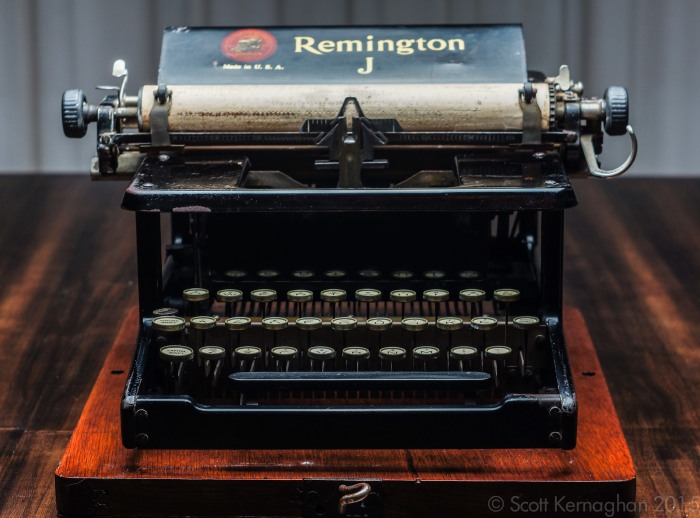
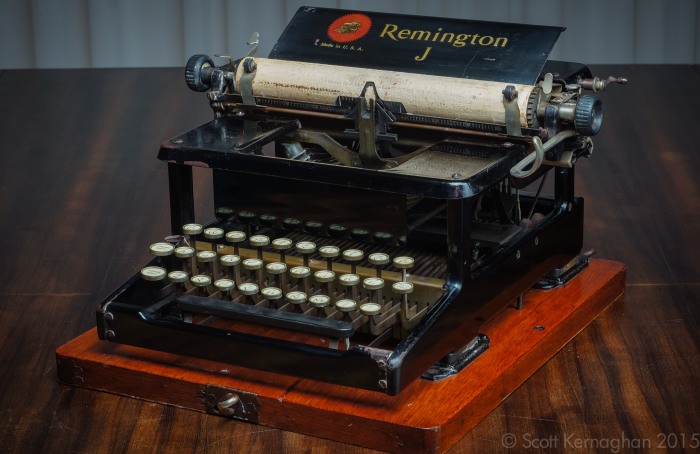
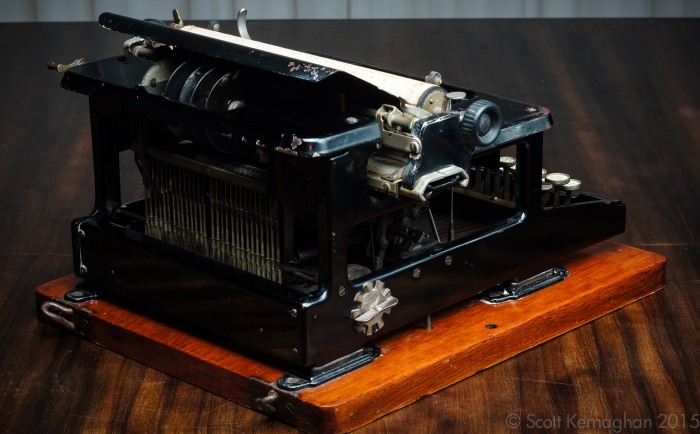
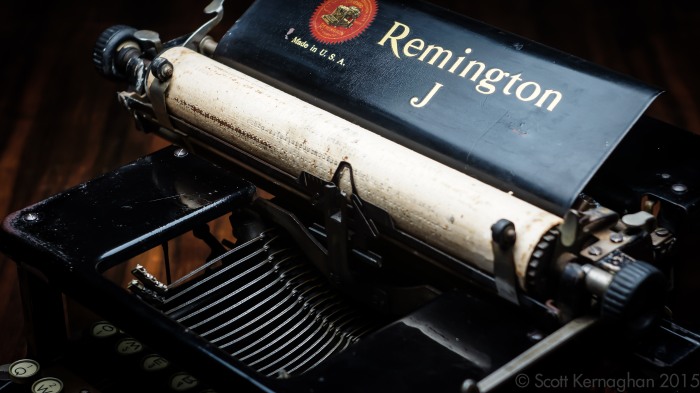
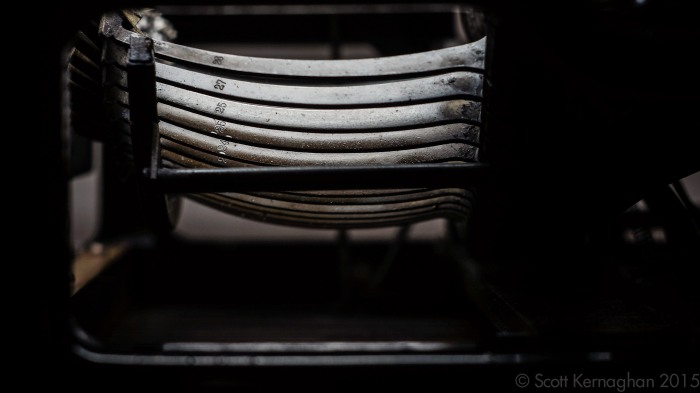

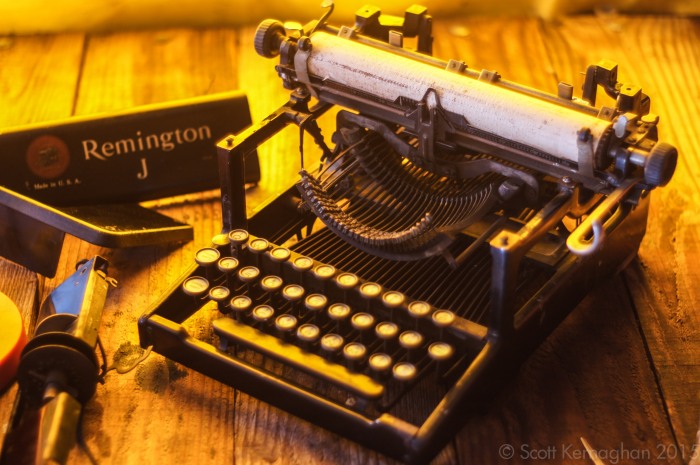
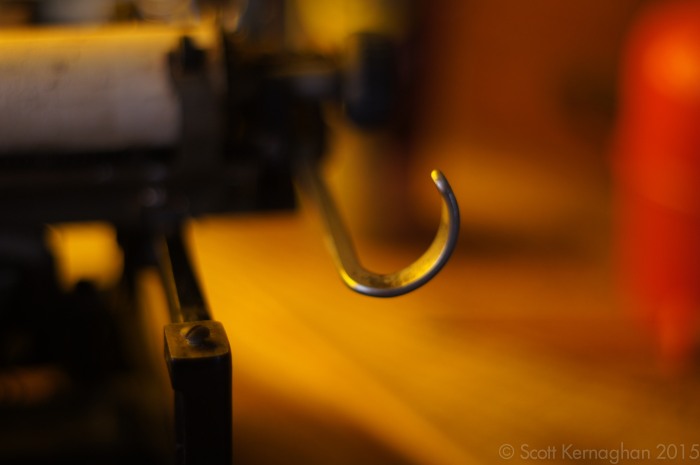
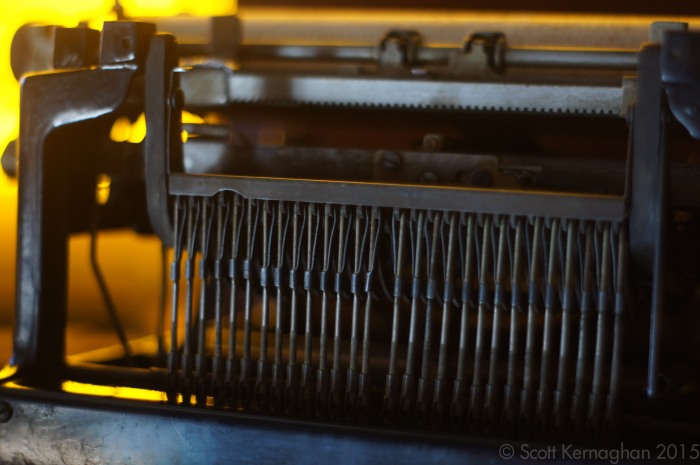
I wonder if there’s some part of a collectors evolution that takes him or her further back in time? It is great you had fun getting this one into such nice condition!
LikeLike
I very nearly found myself going down the same path as you, being able to use a Blick in person (and wanting one, of course) and then almost winning a Hammond Multiplex on ebay. My collection is entirely 4-bank front-strike machines (excepting the Corona 3) and it would be nice to have machines with entirely different designs.
It’s interesting how long 3-bank machines survived alongside their 4-bank relatives.
In the 1920s and 30s, Rand McNally had two different series of road maps for each state, a senior and a junior. I imagine naming things this way must have been common back then, although I will say their junior maps were underdeveloped (aka lacking useful detail) and lesser compared to the senior.
LikeLike
My preference is for later post-war typewriters, but I do like the deceptively simple look of Old Junior.
LikeLike
It’s a fun machine. I don’t see myself departing too far from the post war ones myself, but it is still great to have.
LikeLike
Great post & great machine, Scott. I love the twin ribbon spools in the rear center and the fact that the carriage return seems to be below the level of the platen. Typewriter design, ever evolving. I once passed up an an apothecary keyboard Jr and I’m still kicking myself.
LikeLike
Thanks Rob. You do have some great luck with those apothecary machines! Damn you missed it.
LikeLike
What a bargain! Glad you saved it.
I did not know about the negative connotations of “Junior” in some countries.
Good to have you in the ETC gang.
LikeLike
Well, it’s simply seeing it as ‘childish or child-like’ really. Thanks Richard, happy to be on board. Oh, and BTW… I might have an article for you in the future.
LikeLike
Congratulations on this rare and fine looking J.
Looks like this is a very accessible, open and fun machine to work on! (Though open-looks can be deceptive 😉
Good reading. Made me think a bit about that shifting of focus – so fare have stayed far from the few rare items popping up. Had however told myself to stay on thirties’ portables, yet did go for the twenties’ RP2 (and it is much fun to own and work with!). Is there a pattern…?
(-:
LikeLike
Actually, it is very accessible. Its a great machine. And I do think there is a bit of a pattern there. I think the more you explore, the more you look for. It’s kind of a natural progression.
LikeLike
Aaaah! So that’s why you changed your header photo. Looks great though.
What’s the size of a J like this? Comparable to an Underwood 5? It looks “small” for a desk standard.
LikeLike
Mmmm It’s longer at the base than an Underwood 5, but shorter in height.
I just changed the title because I felt it needed a little classing up!
LikeLike
Pingback: Old Weirdy: Century 10 | myoldtypewriter
Pingback: The Sorta-Portable Century 10 Typewriter | myoldtypewriter
Hi Scott,
I’m a student at Central Tafe in Perth, Australia assigned to create photo-realistic imitation artwork of a photo. I was wondering if I would be allowed to select the photo -second from the top- to create? I can send you a copy if you require.
RSVP as soon as possible.
Thanks!
LikeLike
Hey there Christine. I’ve sent you an email. Great to hear from you!
LikeLike
Hi, I just become a proud owner of a typewriter just like this today… also with only the letter J , can u tell me were to find the serial number… =) / best regards from Sweden
LikeLike